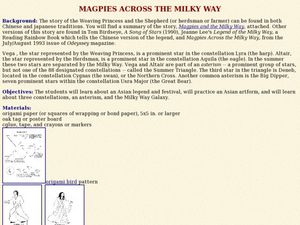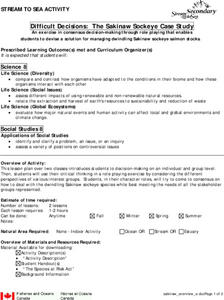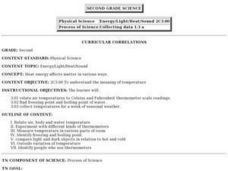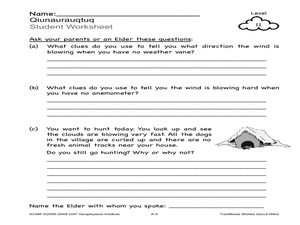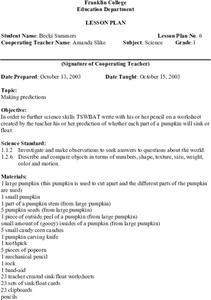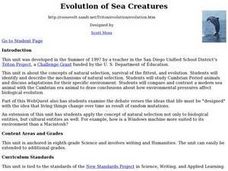Curated OER
Magpies across the milky way
Students make origami birds after studying about Asian legends and culture. In this Asian legends lesson plan, students also learn about Asian art, constellations, and the Milky Way Galaxy.
Curated OER
Plants and Animals of Great Bay Animals and Plants of the Estuary
Students participate in a webquest about the plants and animals that inhabit an estuary. They role play as environmentalists researching this habitat and present the results of their research in a creative way.
Curated OER
Observation Hike
Students participate in an observational hike to study the natural surroundings. In this observational hike lesson, students hike through a state park and observe the plant and animal life. Students learn about appropriate...
Curated OER
Living During the Little Ice Age
Students brainstorm what living conditions during the period known as the Little Ice Age (1350-1850) might have been like. They research lifestyles, the economy, crop yields, and human and livestock mortality.
Curated OER
Proper Hygiene
Third graders discuss the importance of personal hygiene and cleanliness. They examine why good oral hygiene is a significant part of maintaining a healthy body. They focus on the need for daily baths, hair care, and teeth cleaning. They...
Curated OER
What Color is Your Colony?
Students conduct an experiment to change the color of E. coli bacteria using genetic engineering. They work in small groups to add a plasmid containing a gene for red pigment to the bacteria and culture the bacteria to see if it ...
Curated OER
Photosynthesis
Seventh graders investigate a multidisciplinary unit with an emphasis in using technology in order to engage them. The students perform Internet research about photosynthesis with a written assessment taken from the WebQuest.
Curated OER
Cranes, Crosswalks, and Big Gulps
Students watch a video and answer questions based on wildlife jobs. In this wildlife lesson plan, students learn that biologists don't just play with animals but that there is a lot of study involved.
Curated OER
Canoe and Kayak
Students explore canoes and kayaks. In this canoe and kayak activity, students research the history, parts, and sport of the canoe and kayak. Students then practice how to use a paddle for each boat, and go on a field trip in order...
Curated OER
Special Place
Students observe and describe a "special place" chosen along a nature trail. In this habitat observational skills and writing lesson, students take a walk on a nature trail and choose a spot to sit and meditate. Students complete a...
Curated OER
Difficult Decisions: The Sakinaw Sockeye Case Study
Eighth graders examine Sakinaw Sockeye as species at risk, participate in role playing exercise to consider different perspectives of various interest groups, and try to come to consensus on how to deal with dwindling Sakinaw sockeye...
Curated OER
Heat Energy- Temperature
Second graders investigate the meaning of temperature. They determine what happens to a thermometer when the temperature rises or falls. They place thermometers in different classroom locations in order to compare the temperature in a...
Curated OER
Traditional Stories about Wind
Students observe and talk about wind using no weather instruments. For this wind lesson plan, students use their senses to observe wind. They also interview an Elder about wind.
Curated OER
Is There A Fungus Among Us?
Sixth graders classify fungus into two different groups. In this fungus activity, 6th graders collect as many pieces of fungus as possible. Students then classify these pieces of fungus as saprophytic or parasitic.
Curated OER
Do Different Colors Absorb Heat Better?
Students work together to test how the color of a material affects how much heat it absorbs. They make predictions and take notes on their observations. They discover how engineers use this type of information.
Curated OER
Using VNTR Analysis to Identify Guilt at a Crime Scene
Students collect DNA from cheek cells. They compare and contrast the processes of DNA replication and PCR. They discuss how this information can be used to determine guilt at crime scenes.
Curated OER
Making Predictions
First graders write with his or her pencil on a worksheet created by the teacher his or her prediction of whether each part of a pumpkin will sink or float. They drop each of five objects in the water one at a time allowing enough time...
Curated OER
It's a bright and beautiful day...Protect Yourself!
Students investigate the cause and effect of skin cancer. They complete worksheets, view presentations and discuss the various types of ultraviolet rays and their impact on human health.
Curated OER
Beach Erosion Investigation
Students determine the effects of gentle and strong waves on beach erosion. They use a stream table to simulate a beach and sketch the beach profile after simulated waves of different sizes.
Curated OER
Evolution of Sea Creatures
Students identify and describe the mechanisms of natural selection. They study Cambrian Period animals and discuss adaptations for their specific environment.Students compare and contrast a modern sea animal with the Cambrian era animal...
Curated OER
How Appropriate is that Tree?
Students identify trees and their environments using a dichotomous chart. In this exploratory activity students use the Internet to identify conditions needed for the trees and what the climate is in their area.
Curated OER
Endangered Species of PA
High schoolers research and publish information about an endangered species on the school's web site. For this endangered species lesson, students choose an at-risk species to research. They publish their research information on the...
Alabama Learning Exchange
What Color Are The Leaves?
Young scholars identify the colors in leaves. In this chromatography instructional activity, young scholars read the book Why Do Leaves Change Color? and construct chromatography strips to identify the colors of leaves.
Curated OER
Climate in Our Back Yard
Students construct a "A Year in Pennsylvania" poster on which they creatively describe at least three examples of how the climate they live in shapes their lives during every season of the year.


